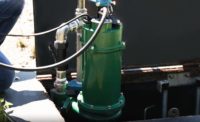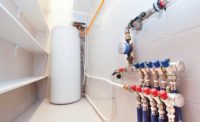Wastewater from a building’s fixtures is supposed to be carried to a public sewer main, then on to a treatment plant and ultimately returned to the environment where it can lead a disinfected and productive second life.
But sometimes a home or business sewer line is at a lower elevation than the sewer main.
That is where the sewage pump or a sewage grinder pump comes into play. These pumps are traditionally put in some sort of tank and buried either in the basement or outdoors. When water is used, wastewater is collected and stored in a holding tank. When it reaches a preset level, the pump is activated, pumping the waste out into the sewer system.
However, not surprisingly, pumps can be susceptible to certain problems. Regular “solids handling” sewage pumps simply try to pass solids along. What goes in comes out, or at least it tries. Certain waste items such as diapers, articles of clothing or towels will clog regular pumps. Even if the pump can pass along some of these things, if the solid is larger than the pipe diameter, then the items can clog the pipes.
Grinder pumps are designed to chew waste into a fine slurry. However, many units also can be susceptible to problems. Failure of these pumps can come in different forms, but they all cause the same outcome. Wastewater from the residence or building stops flowing, an alarm may go off and backup can occur if the alarm is ignored. For obvious reasons, this is not desirable.
There are three distinct grinder pump products:
-
A single-stage centrifugal grinder pump uses a single impeller, spinning on a shaft, powered by a motor to create the pumping action. Wastewater is pumped through the cutters that grind, shred or cut the material being pumped out of the basin. Single-stage centrifugal grinders typically are used in applications that require lower discharge heights (less than 90 feet).
-
A two-stage centrifugal grinder pump basically is the same as the single-stage unit but it has two impellers instead of one. Two-stage centrifugal grinders typically are in the 140 feet-of-lift range.
-
A semi-positive displacement grinder is powered by a motor turning a stainless steel screw-type rotor that spins inside a rubber stator that creates a pumping action. This type of grinder pump allows for higher pumping heights as the material is squeezed inside the rubber stator, pumping the wastewater through the pump and out the basin. Semi-positive displacement grinders typically are used in applications that require higher discharge heights, typically in the 140 feet-of-lift range, sometimes higher.
What are common problems of grinder pumps?
Different types of grinder pumps can fail for different reasons. Here’s the top six causes:
-
Wadding: Material can accumulate on the cutting mechanism, blocking the flow of water, overheating the pump and even burning out the motor.
-
Jamming: Material actually can get impacted inside the cutter mechanism to the point where it overcomes the torque of the motor and stops it.
-
Clogging: Ground material that gets past the cutting mechanism can clog up inside the pump housing, blocking water or stopping the impeller.
-
Rubber stator failure: Macerated waste and pressure can wear on a rubber stator causing it to fail and render the pump useless.
-
Motor burnout: Some pumps must be applied to the right pressure and flow. Improperly applied pumps can overload and burn out the motor.
-
Seal failure: A common pump problem where the main seal fails, allowing water to get into the motor. This problem can be aggravated in a grinder pump because the ground material actually can wrap around the seal and cause it to fail.
How can you avoid these problems?
There are some cutter technologies on the market that are designed to eliminate the issues of wadding, clogging and jamming that traditional cutters have. They provide superior shredding performance in demanding sewage applications. The stainless steel cutting systems aggressively shred jeans, shop rags, diapers, sanitary napkins and other difficult solids into fine slurry.
Seals: Traditionally a double mechanical seal arrangement is used because it is common for the first seal to fail since it is vulnerable to foreign/stringy material. This material gets wound around the shaft and can split the seal faces open. The lip seal keeps debris or stringy material away from the upper mechanical seal and the foreign material does not hinder it. The upper seal should be a high-quality unitized silicon carbide seal that provides hard-seal faces that will not wear out. Silicon-carbide seals are better and more reliable than ceramic-carbon seals used by some manufacturers.
Starting circuit: In order to provide the most power at startup, grinder pumps typically have a separate starting circuit, which is assisted by its own capacitor. When the pump comes up to speed, the start circuit shuts off by means of a switch. The best pump-starting switch is one that will not wear out. Some grinders have relays with coils and contacts that can wear out. Some have a solid-state starting circuit without a relay. There are no contacts or coils to burn up after many cycles.
Some pumps have a specific pumping zone and can only operate within a specific pressure range. This is referred to as a pump with a minimum head requirement. If it operates without enough backpressure (referred to as head or feet of lift), then it can end up “over pumping” and can burn out the motor.
The pump manufacturer always provides a performance curve. Look for a pump that can operate anywhere within its performance curve.



